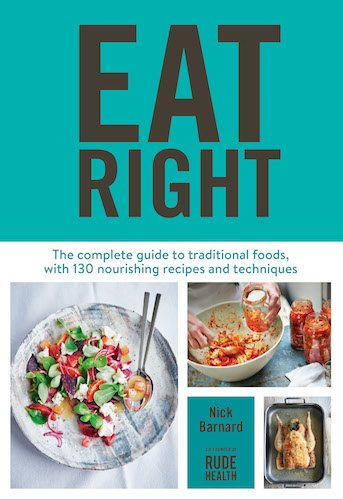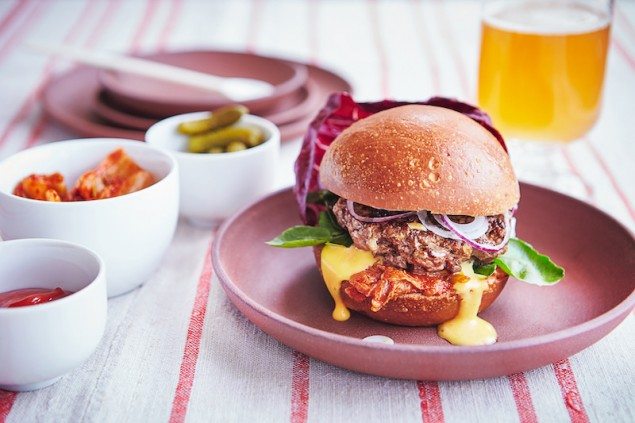
London-based Nick Barnard has debuted a new cookbook, Eat Right: The Complete Guide to Traditional Foods, With 130 Nourishing Recipes and Techniques that throws aside any current diet trends and instead encourages us to take our eating back to how our ancestors prepared their meals. From raw dairy to pickling the season’s produce, the book dives into how to have a balanced diet, while eating delicious food. Here are some of our favorite tips from the book:
Dairy
Search out raw milk and dairy products. The flavor is far superior and you benefit more from its nutrients. If you are unable to eat or find raw products, then be sure to find milks that are not homogenized.

Meat
Eat meat only on occasion. Try to buy grass-fed meats that will be higher in heart-healthy fats and you’ll know the animals had a healthy existence. The book shares a recipe for an ultimate burger that is absolutely perfect, but remember, our ancestors did not eat burgers everyday. Foods like that (with meat and cheese) were a treat. Check out the recipe below.
Fats
Seek out traditional animal fats like your ancestors used to use, think lard, butter and tallow. Also incorporate olive oil and coconut oil into your cooking. Stay away from any refined fats. The book teaches you how to properly render pork, lamb, poultry and beef fat. Good lard or butter from a pasture-raised animal come with more benefits than just normal, refined fat or low-quality animal fats. Instead of taking omega-3 vitamins, just eat pasture-raised animals fats and dairy like our ancestors did.
 Water Kefir
Water Kefir
Fermented Foods
Get back to our roots and increase the intake of fermetnted foods that help create a healthy microbiome in our body. The book goes into how to make your own kefir, yogurt, sauerkraut and kombucha, just to name a few.
 Sprouted Sourdough Pizza
Sprouted Sourdough Pizza
Sprouting
Sprout your seeds, nuts, and legumes in order to bring out even more nutrients in the germinating life form. The foods become even more flavorful and nutrient rich.

Ultimate Oats
Search out oat groats for your morning oatmeal, sprouted oats or steel cut oats to make sure you’re getting the most nutrients for your buck. Stay away from quick or instant oats. Always soak your oats the night before you plan to cook them so you can speed up the process in the morning, but also to neutralize their phytates which block mineral absorption.
Add Beef Heart
Once you find a good butcher, have then add some beef heart to your ground beef mixture. Beef heart is a sneaky way to increase nutrients like iron, zinc, thiamine and much more.
Seafood
We all know that fish are loaded with so many beneficial nutrients. However, we have to be sure that the fish we are catching and eating are not harming the environment. Nick suggests staying away from all farmed fish unless you can prove the establishment is using sustainable practices and to choose your wild fish based on checking with a seafood watch like the Monterey Bay Aquarium Seafood Watch. Once you have selected an environmentally friendly fish to cook, check out the book for easy preparations of the seafood.
Sugars
When buying a sweetener, skip the usual refined white sugars. Instead, use raw honey, maple syrup, unrefined cane juice sugar, coconut sugar or jaggery. They should be used sparingly still, but help our bodies become less addicted to the sweet stuff. Our ancestors ate sugar sparingly and mostly for special occasions, we should too.

Hamburgers
- Yield: 4 servings 1x
Description
OF LATE, HAMBURGERS HAVE BEEN REHABILITATED AS A GOURMET TREAT. This is a good thing. For too long a hamburger has been a popular convenience food for all the wrong reasons. Now there are restaurants, cafés, and even specialty fast-food chains selling burgers made with high-quality ingredients, such as aged beef from traditional breeds, wild game meat, freshly made buns with simple ingredients, as well as an ever-changing selection of nutrient-rich toppings and fillings, such as raw milk cheeses and fermented pickles. Making your own super flavorful and nutrient-dense burgers is extremely simple. All you need is your friendly butcher with his trusted source of pastured (grass-fed) beef that has been (dry) aged, and a willingness to grind beef for you from the richly marbled cuts of meat such as chuck and shin. You don’t want lean ground beef here—in fact, not ever. To pimp up the nutrients, have your butcher add some beef heart to your mixture. Unlike other organ meat, beef heart is, of course, muscle meat. It is packed with rich goodness, including enhanced levels of protein, iron, selenium, phosphorus, zinc, CoQ10, folate, thiamine, and other B vitamins. CoQ10? This is a coenzyme, somewhat similar to a vitamin. It is held to give considerable health benefits but there is no clear consensus or understanding as to its precise efficacy. What is certain is that it plays a key part in our metabolic processes, and that given that our food regimes are so often nutrient, trace element, and mineral deficient, it is a boon to boost our wellness with such precious natural supplements. That’s a good way to consider organ meats: as natural supplements. The trick is how to sneak them into everyday foods; adding about 10 to 20 percent beef heart to all your ground beef is a perfect solution. How to cook hamburgers? It’s all about balancing health with taste. What seems clear is that flame grilling and barbecuing can be a rather brutal way to cook foods. Depending on the fuel you use, there may be toxins in the smoke, and if any flames come in direct contact with the meat, there is evidence that carcinogens are created. Use a barbecue sparingly, as a treat, with natural charcoal as a fuel, and make sure that you don’t flame the foods. It’s okay, however, to cook your vegetables on the barbecue this way. Better to cook burgers, like your steaks, in a cast-iron frying pan, and if you want to mimic the grill, then use a cast-iron griddle or ridged pan.
Ingredients
- 1 ¼ pounds freshly ground beef from aged chuck or shin cuts that come from pastured traditional beef breeds (with some (10 to 20 percent) beef heart (optional))
- 2 or 3 garlic cloves (smashed and finely chopped)
- Sea salt and freshly ground black pepper
- Extra virgin olive oil or tallow
- 4 burger buns (brioche style, freshly made, by an artisan baker)
- Butter (preferably raw)
Condiments—select from
- Sliced Gruyère or aged Cheddar cheese made with raw milk
- Kimchi
- Sauerkraut
- Pickled or lacto-fermented gherkins
- Fresh arugula or other strongly flavored green (like watercress or radicchio)
- Slightly fermented tomato sauce (and homemade mayonnaise)
- Onion rings or sliced onions sautéed in ghee until lightly caramelized
Instructions
- Mix the garlic into the beef, along with a couple of big pinches of salt and some freshly ground black pepper.
- Form into 4 patties, slightly smaller in diameter than the buns. Or, if your buns are small, make the burgers no more than 1-inch thick or they won’t cook through properly.
- Smear the burgers with a little olive oil or tallow to help prevent them from sticking in the pan. Slice and butter the buns, and prepare any condiments, such as the onions.
- Heat your frying pan over medium-high heat. When it is about to smoke, lower the heat to medium and cook the burgers, two at a time. Press them down lightly onto the pan, and then leave alone for 3-5 minutes each side, depending on their thickness. You’re looking for a medium–rare finish; you can’t really tell by pressing the burger, so if in doubt, cook for less time. You can always return the burger to the pan.
- Place another frying pan, preferably a grill pan, over medium heat, and once you’ve flipped the burgers put the buns butter–side down onto the frying pan and remove when they are lightly browned.
- Once you’ve flipped the burgers, press them down lightly again and cook for another 3 to 5 minutes. If you want a cheeseburger, now is the time to lay a slice of cheese on top.
- Serve immediately with an array of nutrient-dense condiments.












